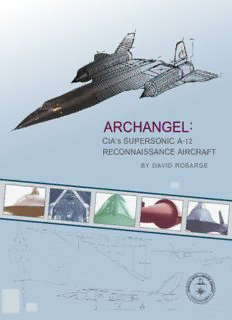
Archangel PDF
Preview Archangel
: ARCHANGEL CIA’s SUPERSONIC A-12 RECONNAISSANCE AIRCRAFT BY DAVID ROBARGE The Center for the Study of Intelligence (CSI) was founded in 1974 in response to Director of Central Intelligence James Schlesinger’s desire to create within CIA an organization that could “think through the functions of intelligence and bring the best intellects available to bear on intelligence problems.” The Center, comprising both professional historians and experienced practitioners, attempts to document lessons learned from past activities, explore the needs and expectations of intelligence consumers, and stimulate serious debate on current and future intelligence challenges. To support these efforts, CSI publishes Studies in Intelligence and books and monographs addressing historical, operational, doctrinal, and theoretical aspects of the intelligence profession. It also administers the CIA Museum and maintains the CIA Library’s Historical Intelligence Collection. Comments and questions may be addressed to: Center for the Study of Intelligence Central Intelligence Agency Washington, DC 20505 Copies of this book are available to requesters outside the US government from: Government Printing Office (GPO) Superintendent of Documents P.O. Box 391954 Pittsburgh, PA 15250-7954 Phone: (202) 512-1800 E-mail: [email protected] ISBN: 978-1-929667-16-1 Second Edition, January 2012 : ARCHANGEL CIA’s SUPERSONIC A-12 RECONNAISSANCE AIRCRAFT DAVID ROBARGE CIA CHIEF HISTORIAN CENTRAL INTELLIGENCE AGENCY WASHINGTON, D.C. Second Edition 2012 FOREWORD This history of the A-12 reconnaissance aircraft was occasioned by CIA’s acquisition on loan from the Air Force of the eighth A-12 in the production series of 15 in September 2007. Known as Article 128, the aircraft is on display at the Agency’s Headquarters compound in Langley, Virginia. This history is intended to provide an accessible overview of the A-12’s development and use as an intelligence collector. Writing this story was a fascinating challenge because I am not an aviation historian and have never flown any kind of aircraft. Accordingly, I have tried to make the narrative informative to lay readers like myself, while retaining enough technical detail to satisfy those more knowledgeable about aeronautics and engineering. I have drawn on the sources listed in the bibliography and the extensive files on the A-12 program in CIA Archives. Hundreds of those documents were declassified and released to the public in conjunction with the dedication of Article 128 in September 2007 as part of the Agency’s 60th anniversary commemoration. I have limited citations to specific documentary references and direct quotes from published works. When discrepancies arose among the sources regarding dates and other details, I have relied on the official records. For their contributions to the substance and production of this work and to the documentary release, I would like to thank my colleagues on the CIA History Staff and at the Center for the Study of Intelligence, the information review officers in the Directorate of Science and Technology, designers and cartographers in the Directorate of Intelligence, and publication personnel at Imaging and Publishing Support. I also am grateful for historical material provided by the Lockheed Martin Corporation and the A-12 program veterans, the Roadrunners. David Robarge CIA Chief Historian January 2012 iii CONTENTS From Drawing Board to Factory Floor 1 Breaking Through Technological Barriers 11 Full Stress Testing 21 Hiding OXCART in Plain Sight 27 Finding a Mission 31 A Futile Fight for Survival 41 References 47 A-12 Schematic Timeline of OXCART Milestones Inventory of A-12s BLACK SHIELD Missions The OXCART “Family” Bibliography v FROM DRAWING BOARD TO FACTORY FLOOR A depiction of the A-12 on its first operational flight in May 1967. Entitled “Untouchable,” the painting, by artist Dru Blair, hangs in CIA’s Intelligence Art Gallery. @ Dru Blair.
Description: